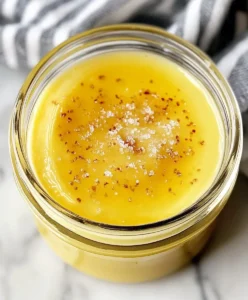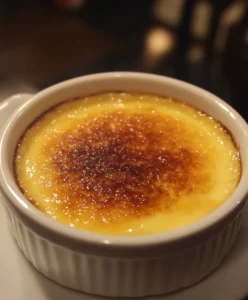Introduction: Unlocking the Art of Crème Brûlée Perfection
The secret to crème brûlée is all about technique. This elegant French dessert features a rich, creamy custard topped with a crisp caramelized sugar layer. To achieve perfection, you need to master a few key steps. In this guide, we’ll reveal the 5 secrets to crème brûlée that will help you create a flawless dessert every time. Whether you’re a home baker or a professional, these tips will elevate your crème brûlée skills.
A Brief History of Crème Brûlée: From Tradition to Masterpiece
French Roots of Crème Brûlée Recipes
Crème brûlée has its origins in 17th-century France, where it was first documented in François Massialot’s cookbook. Known as “Burnt Cream” for its caramelized topping, it quickly became a symbol of refined French cuisine.
Cultural Adaptations of Classic Crème Brûlée
Variations of crème brûlée have emerged across Europe. In Spain, crema catalana introduces citrus and cinnamon, while England’s Trinity cream is often branded with a hot iron to create its signature crust.
Crème Brûlée: A Worldwide Culinary Icon
Today, crème brûlée is a beloved dessert worldwide, with chefs adding innovative twists to this classic. Its versatility ensures its place in both traditional and modern menus.
The Science of Perfect Crème Brûlée
Egg Yolks and Custard: A Creamy Foundation
Egg yolks are the cornerstone of crème brûlée’s custard. They act as an emulsifier, creating a velvety texture when combined with cream and sugar. The delicate balance of these ingredients is crucial to achieving a smooth custard.
Caramelization: The Secret to a Perfect Crème Brûlée Crust
Caramelization takes place when sugar is heated to its melting point, causing it to break down and develop a rich, golden color and complex flavors. This process creates the signature glass-like crust on top of crème brûlée, offering a delightful contrast to the smooth, creamy custard beneath. The crisp caramel layer adds both texture and depth to this classic dessert.
Water Bath Technique for Evenly Cooked Crème Brûlée
A water bath, also known as a bain-marie, is essential for ensuring the custard cooks gently and evenly. By surrounding the ramekins with hot water, this method provides consistent heat distribution, preventing curdling and overcooking. It plays a crucial role in maintaining the dessert’s silky smooth texture, resulting in a perfectly creamy custard every time.

Essential Ingredients for Making Crème Brûlée
The Role of Fresh Ingredients in Authentic Crème Brûlée
Using high-quality ingredients is essential for creating the perfect crème brûlée. Fresh eggs, premium cream, and fine sugar form the foundation of this classic dessert. The freshness and quality of these ingredients significantly enhance the flavor, texture, and overall indulgence, ensuring a rich, creamy custard with a flawlessly caramelized crust.
Vanilla: A Key Flavor in Crème Brûlée Recipes
Vanilla is the quintessential flavoring for crème brûlée, providing its signature aromatic profile that defines the dessert’s character. Whether you choose to use whole vanilla beans, with their rich specks of seeds, or high-quality vanilla extract, this timeless ingredient infuses the custard with a warm and inviting flavor, enhancing its creamy and luxurious texture.
Alternative Flavoring Ideas for Unique Crème Brûlée Variations
Experiment with unique flavors like lavender, citrus zest, or matcha to add a new dimension to this classic dessert. These ingredients introduce subtle yet intriguing notes that complement the creamy base without overpowering it. Lavender adds a delicate floral touch, citrus zest brings brightness and freshness, while matcha imparts an earthy richness, creating exciting variations that elevate the traditional recipe.
How to Make Crème Brûlée Like a Pro
Crafting the Custard for Flawless Crème Brûlée
Begin by whisking the egg yolks and sugar together until the mixture becomes pale and slightly thickened. Gradually add the warmed cream in a slow, steady stream while continuously whisking to temper the eggs. This method prevents the eggs from curdling and ensures a smooth, well-incorporated custard base, ready for baking or further flavoring.
The Water Bath Method: A Step for Perfect Crème Brûlée Results
Place the ramekins in a deep baking dish and carefully pour hot water into the dish until it reaches halfway up the sides of the ramekins. This water bath method, also known as a bain-marie, protects the custard from direct heat and promotes gentle, even cooking. It helps prevent overcooking and ensures a smooth, creamy texture throughout the custard.
Baking Tips for Consistently Creamy Crème Brûlée
Bake the custard at a low temperature, around 300°F (150°C), until it is set but still slightly jiggly in the center when gently shaken. This slow and gentle cooking process helps maintain the custard’s creamy texture. Be careful not to overbake, as this can cause the custard to become rubbery or lose its smooth consistency.
Creating the Caramelized Sugar Crust
Selecting the Best Sugar for Crème Brûlée Toppings
Superfine sugar is the ideal choice for creating a uniform crust on your dessert. Its fine grains melt quickly and caramelize evenly, resulting in a smooth, golden finish. This ensures a perfect balance of crispness and flavor, enhancing the overall texture and presentation of the dish.
Caramelization Techniques for the Perfect Crème Brûlée Finish
A culinary torch offers the precision needed to create a perfectly caramelized sugar crust, allowing you to control the heat and achieve an even, golden finish. Alternatively, you can use a broiler to caramelize the sugar, but this method requires close monitoring to prevent uneven browning or burning. Both options can deliver excellent results when handled carefully.
Achieving a Balanced Crème Brûlée Crust Thickness
For the perfect balance of crunch and sweetness, spread a thin, even layer of sugar over the surface of the custard. Using just the right amount ensures a delicate, crisp crust that complements the creamy custard beneath. Avoid adding too much sugar, as it can create an overly thick and hard crust, detracting from the dessert’s texture and enjoyment.
Avoiding Common Mistakes When Making Crème Brûlée
Preventing Overcooked Custard in Crème Brûlée
Keep a close eye on the baking process to achieve the perfect custard consistency. Using a thermometer can be especially helpful to ensure the custard does not exceed 175°F (80°C), as overheating can cause it to curdle or become grainy. This precise temperature control helps maintain the custard’s smooth, creamy texture for a flawless result.
Avoiding Cracks in Your Homemade Crème Brûlée
Cracks in custard often occur when it is cooked too quickly or at a temperature that is too high. To prevent this, use a water bath, also known as a bain-marie, which gently and evenly distributes heat around the custard. This method helps maintain a stable cooking temperature, reducing the risk of cracks and ensuring a smooth, creamy texture in the final dish.
Tips for Even Caramelization in Crème Brûlée
To achieve the best results, ensure the sugar layer is evenly distributed across the surface of the custard. Use a fine granulated sugar and spread it in a thin, uniform layer to avoid uneven caramelization. When using a torch, work methodically, moving the flame in steady, circular motions to melt and caramelize the sugar evenly. This careful approach creates a beautifully golden, consistent crust that enhances both the texture and appearance of the dessert.
Creative Crème Brûlée Recipe Variations
Chocolate Crème Brûlée: A Decadent Twist
Enhance your custard by incorporating melted dark chocolate for a rich, indulgent dessert that’s sure to delight chocolate lovers. The velvety texture and deep chocolate flavor elevate the dish to a decadent treat. Pair it with fresh berries, such as raspberries or strawberries, for a burst of brightness and complementary flavor, creating a perfectly balanced and luxurious dessert.
Fruity Crème Brûlée: Incorporating Seasonal Purees
Dairy-Free Crème Brûlée Options for Every Diet
Substitute traditional dairy with coconut cream or almond milk for a delicious dairy-free alternative. These options preserve the dessert’s creamy texture and rich flavor while accommodating dietary needs, making it an inclusive choice that everyone can enjoy. Coconut cream offers a luscious, tropical richness, while almond milk provides a lighter, subtly nutty profile.
Spiced Crème Brûlée for a Festive Flavor
Infuse the custard with warm spices like cinnamon, nutmeg, or cardamom to create a delightful, spiced twist that’s perfect for holiday gatherings. These aromatic flavors add depth and a cozy, festive touch to the dessert, making it a wonderful choice for celebrating the season with friends and family.
Presenting and Serving Crème Brûlée with Style
Garnishing Crème Brûlée for Visual Appeal
Garnish your dessert with fresh fruit, edible flowers, or a sprinkle of chocolate shavings to achieve an elegant and polished finish. These simple yet thoughtful touches not only enhance the visual appeal but also add complementary flavors and textures. Whether it’s vibrant berries, delicate petals, or rich chocolate, these additions transform your dessert into a stunning centerpiece.
Pairing Crème Brûlée with Desserts and Beverages
Serve the dessert alongside a shot of espresso, a glass of dessert wine, or a selection of fresh fruit to enhance the overall dining experience. These thoughtful pairings balance the dessert’s richness, with espresso adding a bold contrast, dessert wine providing a sweet harmony, and fresh fruit offering a light, refreshing touch. Each option elevates the flavors, creating a truly indulgent and well-rounded finish to the meal.
Interactive Crème Brûlée Serving Ideas
Provide your guests with mini torches to caramelize their own sugar crusts for a fun and interactive dining experience. This creative twist not only adds a touch of excitement to the presentation but also allows each guest to personalize the level of caramelization to their liking. It’s a memorable way to elevate your dessert and engage your guests in the process.
Storing and Preparing Crème Brûlée Ahead of Time
Best Practices for Storing Crème Brûlée
Refrigerate the custards for up to two days before caramelizing the sugar to save time and streamline preparation. Make sure to cover them tightly with plastic wrap or lids to prevent them from absorbing any unwanted odors from the refrigerator. This ensures that the custards remain fresh and ready for their final touch, which is the caramelized sugar topping, just before serving.
Serving Chilled Crème Brûlée with a Freshly Caramelized Top
Caramelize the sugar layer just before serving to ensure the crust remains perfectly crisp. The freshly caramelized topping provides a delightful crunch that contrasts beautifully with the smooth, creamy custard beneath. For the best experience, serve the dessert chilled, as the combination of the cool custard and the warm, crisp sugar creates a harmonious balance of textures and temperatures.

Advanced Crème Brûlée Techniques for Enthusiasts
Infused Creams for Unique Crème Brûlée Flavors
Infuse subtle yet sophisticated flavors into your custard by steeping ingredients like tea leaves, fresh herbs, or whole spices in the cream before use. Gently heat the cream with your chosen ingredient, allowing the flavors to meld together. Once infused, strain the cream to remove any solids before mixing it with the eggs. This technique adds a delicate and aromatic touch to your custard, elevating it to a gourmet level.
Layered Crème Brûlée for Stunning Desserts
Create visually stunning layers by alternating different flavored custards in a single dish. To achieve this, pour one layer of custard and allow it to set completely before gently adding the next layer. This technique not only enhances the presentation with contrasting colors and textures but also adds a variety of flavors to each bite, making your dessert both eye-catching and delicious.
Exploring Savory Crème Brûlée Creations
Try experimenting with savory versions by incorporating ingredients like cheese, fresh herbs, or even foie gras into your custard. These creative variations transform the dish into a unique and elegant appetizer, perfect for impressing guests with unexpected flavors and textures. The savory additions complement the creamy base beautifully, offering a delightful twist on the traditional recipe.
Conclusion: Secrets to Perfecting Crème Brûlée at Home
Mastering crème brûlée requires attention to detail and a willingness to experiment. By understanding its history, perfecting techniques, and exploring creative variations, you can create a dessert that’s as delightful to make as it is to eat.
Related article:
What Can You Use Instead of Ramekins for Crème Brûlée?
What’s the Difference Between Crème Brûlée and Custard?
Irresistible Crab Brulee Recipe: A Gourmet Delight

